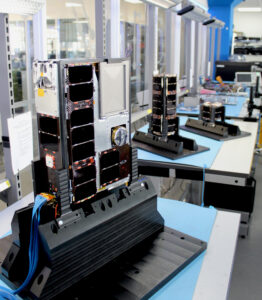Veteran manufacturers question pricing strategy of newcomers
By Debra Werner

SAN FRANCISCO – NanoAvionics, a relative newcomer in the small satellite business, is attracting orders thanks in part to low prices.
For customers, “it’s never just price but it usually comes down to that in the end for selection,” said Brent Abbott, CEO of NanoAvionics US, part of the Lithuanian startup founded in 2014. “Our growth has been in expanding our share of the existing market based on low cost points, credibility in the market and experience on orbit.
Veteran manufacturers questioned that strategy during an Aug. 6 SpaceNews webinar and suggested customers to look beyond price tags.
Customers shouldn’t simply buy the least expensive satellite, said Brian Rider, chief technology officer for LeoStella, a joint venture of Thales Alenia Space and Earth observation company BlackSky.
“They need to be able to rely on that satellite to work,” Rider said. “They need to be able to get the efficiency and the capability out of it that is baked into their business models. If they don’t get that done it’s really just a loss of value from an operations perspective and from an infrastructure perspective.”
Craig Clarke, who founded Clyde Space in 2005 and is now chief strategy officer for AAC Clyde Space, said customers also should evaluate a manufacturer’s track record.
“We don’t compete on price,” Clarke said. “We compete on the fact that we’ve been doing this a long time, we’ve got lots of spacecraft in orbit and our customers value that.”
Marco Villa, Tyvak International CEO, urged satellite manufacturers and satellite customers to take the long view.
“Technology is going to keep on progressing and costs are going to keep coming down because of that,” Villa said. “But the cost of quality assurance and mission assurance is the one that people have to deal with sooner or later.”
Manufacturers agreed the cost of cubesats and small satellites of all sizes will decline as constellation developers and operators begin placing larger orders.
“With mass production, comes an opportunity to really reduce the costs and therefore adjust the price to customers,” Clarke said. “I don’t think that we’re at a point yet where we can see the volume driving the price down.”
NanoAvionics takes advantage of economies of scale by ensuring cubesats of various sizes share common components.
“We make a bus that is adaptable, one that has 80 percent common components,” Abbott said in an online Small Satellite Conference presentation. “We change those based on mission requirements. The algorithms and flight controls stay [consistent] and we focus on the subsystems that support those missions.”
Similarly, L3Harris Technologies has adopted common platforms as a prime integrator of small satellites for government customers.
“We may have an Air Force customer, we may have a Navy customer or an Army customer, but we’re utilizing a lot of the same framework and architecture so that we can get economies of scale of the manufacturing processes,” said Tim Lynch, L3Harris Space and Airborne Systems Multi-Domain Architecture Group executive director. “We try not to make every single one of these satellites a unicorn.”
August 7, 2020 at 09:55AM
via SpaceNews read more...

Post a Comment